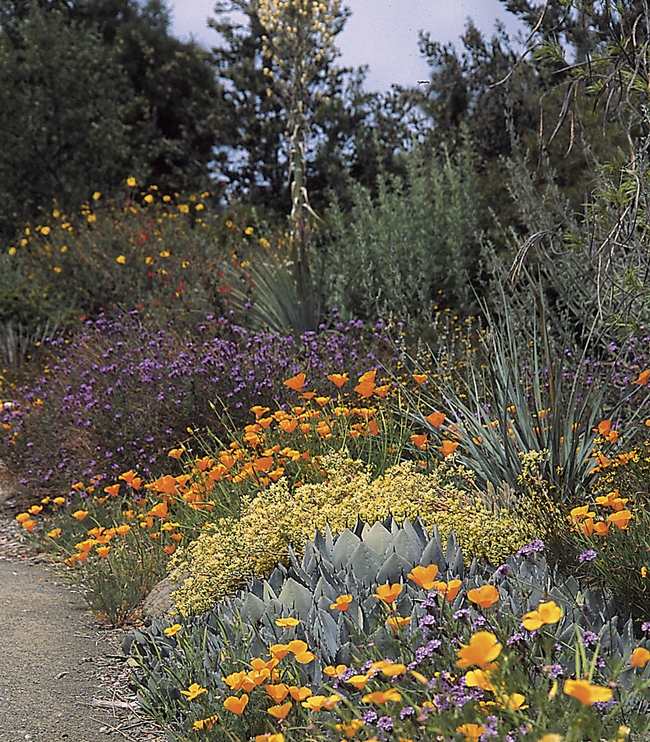 By Susanne von Rosenberg, U. C. Master Gardener of Napa County
By Susanne von Rosenberg, U. C. Master Gardener of Napa County
One of the questions that home gardeners ask Napa County Master Gardeners most frequently is: How much should I water? As with many gardening questions, the answer is: It depends.
Watering adequately is important to avoid stress on permanent plantings such as trees and to keep your vegetables and flowers producing well. When plants don't get enough water, they have to choose between photosynthesis and survival, so they will tend to stop growing. Plants also use water to cool themselves.
You need to adjust your watering to the time of year and the weather. In Napa Valley, plants typically need the most water in early July, when the days are the longest and hottest. By the end of August, plants need about one-third less water than they did at the height of summer because the days are cooler and shorter. By mid-October, they are using only about one-third of the water that they needed in midsummer.
If you water at the same rate all season, you are likely overwatering early and late in the season and underwatering in the middle of summer. Of course, if we get a hot spell, such as the one we just had, your plants will need extra water. While we can normally stop watering when the rainy season starts in October, we've had several years recently when rain came late or not at all. If that happens, you'll need to keep watering.
Here are some additional watering guidelines:
Non-native annual plants, including flowers and vegetables, need to be watered when the soil is dry to a depth of about 1 inch. How do you know that the soil is dry that far down? Simply test the soil with your finger. You'll be able to tell if it's dry or moist. If you prefer not to get dirt under your nails, buy a soil-moisture gauge that uses electrical conductivity to determine if the soil is moist enough. Simply follow the instructions that come with the probe.
You'll want to couple the soil test with your observations. Plants will tell you when they are water stressed. If you are not watering enough, leaves will tend to get dull, and many plants will change the orientation of their leaves from fairly flat (to capture the most sunlight) to more vertical. Some plants will start to fold up their leaves.
Of course, wilted leaves are a pretty good sign that your plants need water. However, squash, pumpkin and cucumber plants are a special case as they will often wilt in the afternoon. If they recover by evening, then they do not need more water.
It's also possible to overwater your plants, which can lead to root rot and fungal diseases. Both problems can cause plants to wilt, which may make you think that you need to water even more. As long as you check your soil, you'll know whether you're watering the right amount.
What about deciduous trees? Young trees need to be watered roughly every two weeks during the dry season. One-year-old trees need one to two gallons of water per day (15 to 25 gallons at a time if you are watering every two weeks). Two-year-old trees need about double that. Three-year-old trees need five to ten gallons per day, and four-year-old trees may need as much as 15 gallons per day.
A mature deciduous tree that is 25 feet tall with a canopy 20 to 25 feet wide may need as much as 50 gallons of water per day (1,500 gallons per month). Mature deciduous trees should typically be watered monthly, although given the large volume of water they need, it may be easier to water them twice a month. Water needs for other perennial plants vary widely. Please contact the Napa County Master Gardeners for more specific information.
Most California native plants are adapted to our dry summers and need little or no water. However, newly planted natives benefit from being watered a couple of times during the summer. By the time they are three years old, they should be able to survive without additional water if we had normal winter rainfall.
During drought years, even most native plants will need some supplemental water in summer. Make sure you know specifically what your native plants need. Some may die if they receive any water during the summer, while others are adapted to moist, shady areas such as creek beds and need a consistent supply of water.
Next workshop: “Home Vineyard: Part 2” on Saturday, September 14, from 9:30 to 2:00 p.m., in Calistoga. Learn techniques to maintain your new or existing home vineyard. Workshop location will be provided after registration. For more details & online Registration go to http://napamg.ucanr.edu or call 707-253-4221.
The UC Master Gardeners are volunteers who provide UC research-based information on home gardening and answer your questions. To find out more about upcoming programs or to ask a garden question, visit the Master Gardener website (http://napamg.ucanr.edu) or call (707) 253-4221 between 9 a.m. and noon on Mondays, Wednesdays or Fridays.